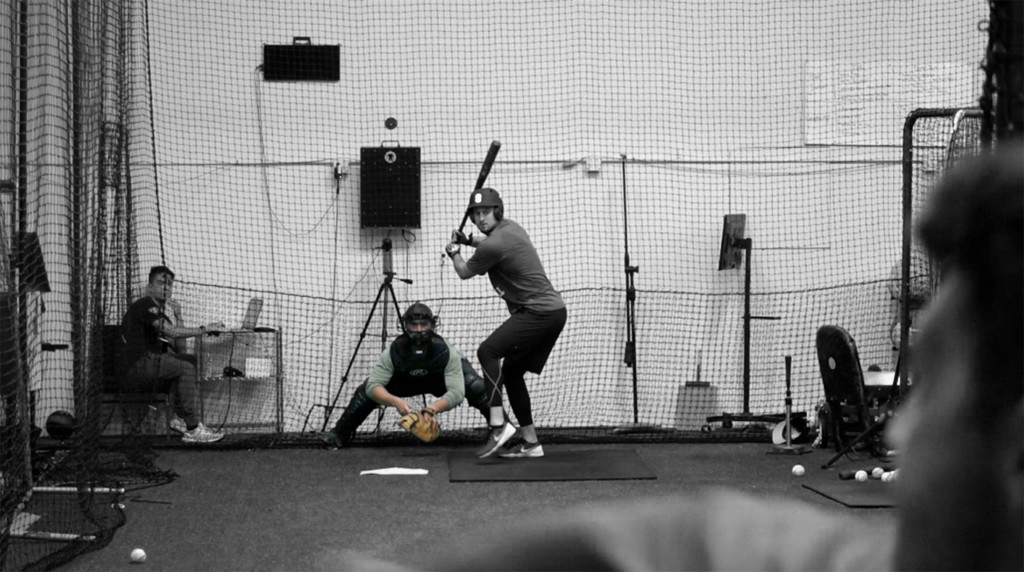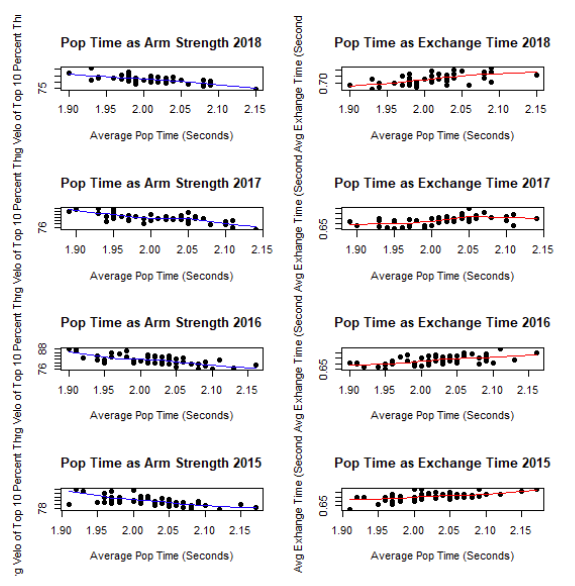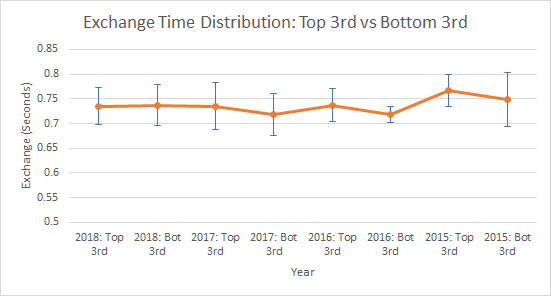Breaking Down Catcher Pop Time

At Driveline, we implement player-development systems based around metrics that will ultimately optimize performance. This piece will break down how we can be data-driven when looking at catcher pop time.For example, from a pitching standpoint we work on developing velocity, designing pitches, and maximizing recovery, among other systems. This intuitive, multi-faceted approach is already being applied in hitting, but we can further apply this to other positions on the field.
Let’s start with the other half of the battery, the guy behind the plate.
We could spend a long time breaking down the ways in which a catcher’s value is determined: receiving, hitting ability, pitch calling, arm strength, etc. But for now, let’s isolate it down to a job they are most well-known for and is also unique to their position: throwing out baserunners.
Breaking Down Catcher Pop time
First, in order to create change and have an impact on a specific metric, we need to understand how it’s measured and broken down. In this case, pop time, or the amount of time it takes for the baseball to travel from the catcher’s glove to the fielder’s glove at second base. While we are aware that other components factor into a runner’s being caught stealing (pitcher’s time to the plate, accuracy of the throw, fielder’s tag, etc.), we also know that pop time is highly correlated with runner’s getting caught stealing.
Let’s break down pop time into two segments:
- Exchange time: the time from a catcher’s receiving the the ball to releasing it.
- Ball flight time: the time from a catcher’s release to a fielder’s receiving the ball.
“As a catcher and coach, when we say that we are going to work on throwing today…[this] turns into an exchange and footwork day instead…not often do we spend time developing arm strength.”—Jacob Garcia, graduate assistant at the University of Washington and former collegiate catcher at University of Northern Colorado
Currently in baseball, there is a persistence that exchange time is the primary determinant of improving a backstop’s value on limiting basepath advances.
Baseball twitter: what do you think is the most important aspect factoring into a catcher’s pop time?@Alex_Caravan and I are working on a little side project breaking down catcher statcast data at @drivelinebases
— Anthony Brady (@BaseballFreak_9) October 6, 2018
As referenced above, the majority of practice time and skill work is spent on transfer technique aimed at decreasing exchange time. Intuitively, this makes sense. Getting the throw off quicker means that the ball should arrive to the fielder faster.
But why not look at the larger component of a base-stealing attempt: ball flight time? The actual throw from the backstop to second base covers approximately 127 feet (some quick Pythagorean math can derive this for the skeptics); it takes just over a second (1.0025 secs) for an 87-mph throw to travel from home plate to second base, and that is without accounting for the ball’s decelerating over time due to factors like drag.
Over a full second is comfortably higher than any major-league catcher’s average exchange time. (The lowest across all qualifying catchers in 2018 was 0.84.) And that’s with an 87-mph throw, which in 2018 was faster than most catchers’ top 10% of throws (faster than 33/46). To further put that into perspective, from 2015 to 2018, exchange time made up only 36.6% of pop time, with ball flight time making up the other 63.4%.
Note: For all analyses and numbers in this piece, we looked at only catchers who had at least 15 throw attempts to 2nd base in said individual year.
So if ball flight time is the largest contributing factor to catcher pop time, shouldn’t there be a greater emphasis on reducing that factor, rather than primarily focusing on exchange time reduction? Furthermore, transferring the ball from glove to throwing hand and into release is a highly technical skill that happens in a short amount of time. Because of this, the exchange is arguably not only a hard skill to master but also even harder to teach and improve.
Alternatively, ball flight time can be reduced by simply throwing the ball harder. While that may not necessarily be easier, here at Driveline, we have a pretty good idea on how to develop arm strength and increase throwing velocity. Before we go any further, let’s dive a little deeper into the stats.
The Stats
Conveniently, Statcast measures the exchange time the same way as it’s defined above, the time from a catcher’s receiving the ball to releasing it. While you can simply calculate ball flight time (pop time – exchange time), Statcast measures arm strength, which we can use as a predictor of ball flight time.
Note: Arm strength signifies the average of the top 10 percentile of all throws for said catcher since Statcast has not yet released throw-by-throw data.
Looking at these metrics for all qualifying catchers in the Statcast era (2015–2018), we can glean a few notable facts just from a quick surface-level analysis.

First, exchange time and arm strength are both significantly correlated with pop time for each year by ANOVA one-way results. Second, each year shows a stronger correlation between arm strength and pop time than between exchange time and pop time.
So yes, reducing exchange time (something catchers universally are trained in and work on) does help in reducing pop time. But more importantly, arm strength (something catchers are much less frequently trained in and focus on) seems to help even more in reducing pop time. (The difference in the strength of correlations was not significant, after a Fisher Z transformation.)
Below are the cold, hard (less glitzy) numbers on the strength of the R-squared values, the square of the correlations.
Arm Strength and Pop Time
But If I try throwing harder, won’t my exchange time slow down?
Not quite.
Analyzing the relationship between these catchers’ arm strength and exchange times, we see a near-nil correlation between the two. In other words, there’s no reason to fear that training will impact the ability to excel in the other one. In addition, looking at descriptive statistics for sub-segments of our population of pitchers, there is no discernable difference in average exchange times between the hardest and the softest throwers.

Graph: A measure of the average exchange times for the noted time periods with their standard errors being noted as tick marks.
A t-test comparison between any of the potential pairings fails to yield significant results; the highest t value only reaches an absolute value of around 0.5 units and a subsequent p-value of 0.33.
Implications and Applications
Based on the breakdown and stats outlined above, there is an argument that catchers should emphasize developing arm strength at a similar level so that exchange technique is emphasized. And that is strictly from the standpoint of throwing out baserunners. Prioritizing arm strength, recovery, arm health, and proper throwing mechanics is extremely valuable for catchers as they throw a baseball more times during a game than any other position. Because of this, there should also be more of an emphasis placed on recovery, arm health, and proper throwing mechanics.
NOT All Catchers Are the Same
Individualizing development is still king. There is not a one-size-fits-all model for catcher development—and there probably never will be. Understanding the breakdown of catcher pop time is valuable for coaches to target specific player’s weaknesses. A catcher with a cannon for an arm and poor exchange technique is in a spot where the majority of the focus should be on skill work aimed at reducing that exchange time. Alternatively, a catcher who comes into a program with elite transfer technique and an average-to-below average arm does not have very much room to improve and refine exchange time with further drill work. However, such a catcher may be in a great place to significantly improve pop time by prioritizing arm strength and implementing a program based around that.
Low-hanging fruit in sports analytics is becoming more and more scarce. Let’s take a moment to appreciate a fairly easy and simple revelation that taps into a baseball catcher’s ability to improve part of their game. While throwing hard might be the best determinant in throwing out runners on the basepath, throwing hard is not something that a catcher’s training program focuses on with appropriate weight.
Comment section
Add a Comment
You must be logged in to post a comment.
Steve Park -
Thanks for the doing the analysis and sharing this. My son who is a catcher and an emergency pitcher has been using your youth program for a few years now and I have no doubt that his sniper skills is a direct result of building arm strength. I look forward to Driveline’s catcher program
Goody -
Really enjoyed this article as I’ve been doing catch to release times for 12 years and have found that most high level catchers will be .70 to .75. The best I’ve ever seen was .58. And of course, velo is the last piece of the pie. One has to be careful of increasing the exchange time to create more velo. What would a catcher do? If he adds a longer stride and a bit more length to the arm action to get the added velo, not enough time left to add say 5 to 6 more mph to make it worthwhile. Stronger arm within same exchange rate is the only option.
Scott Jarnac -
Love what you guys do!! I’ve been analyzing SOFTBALL catchers pop times for about 7 years now, and everything that you said rings true in softball. What I’ve found is that exchange time and accuracy are the 2 major components of throwing out a player stealing in Softball. The faster girls run 2.68 – 2.75 1st to 2nd. My daughters pop averages 1.78. Her exchange averages .75 and flight time around a 1 second. The average pitcher gets the ball to her at average in .55 sec. A catcher throwing a 2 sec pop still has a great chance of throwing any runner out so long as the throw is accurate. What’s funny about girls. is that even though some can throw a ball overhand standing up in the high 60’s few seem to able to throw over 55 mph from behind the plate in a game. We spend a lot of time on exchange and throwing.
Justin Duarte -
Next Level Catching Academy has been working with catchers for almost 10 years now and although arm strength is definitely important, delivery-efficiency (rhythm) tops it. Why? Because as efficiency increases the pop- velo gets closer to its maximum output on throws to 2B. IMO, it’s all about getting the pop-velo as close to the max arm strength velo as possible… and the best way to do that is train the delivery, however, it is possible and recommended to work on delivery and arm-strength because they do go hand-in-hand. Footwork, exchange, ball flight, lower-half output, and arm strength all play a factor. The piece that gets forgotten often is accuracy….increased accuracy is another factor that will increase as the throwing delivery improves. Just my two cents. I’m always learning and appreciate Drivelines articles to stir up thought.
Driveline Baseball -
We appreciate your input! Accuracy is often less talked about but is a vital factor in pop times, as catch to tag is part of the equation in throwing runners out.
Bob -
My thoughts exactly on catchers improving arm strength. While I’m not a catching guy, I make all of our catchers participate in our throwing program. Working on position throws with the blue, red, yellow and gray balls not only is good for improving arm strength but gives the catchers reps on their footwork. Same with infielders and outfielders. OF’s can work on the pro step by mimicking either a fly ball or ground ball. Infielders can work on 2 step or 4 step pattern and we also have a partner feed them the plyo balls to mimick a cutoff situation and work on that footwork as well.
Driveline Baseball -
Hey Bob, you are spot on! You can have athletes feed each other if you want to add an exchange element to the throws. We use our throwing protocols with all of our trainees, pitchers or not, because arm strength plays at every position. PlyoCare throws allow us some freedom to push the speed, quickness, or effort level from what you might get on the field. Plus, the different weights add a challenge. Thanks for your comment.